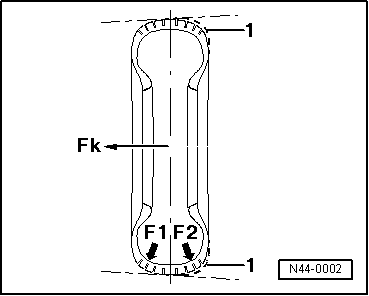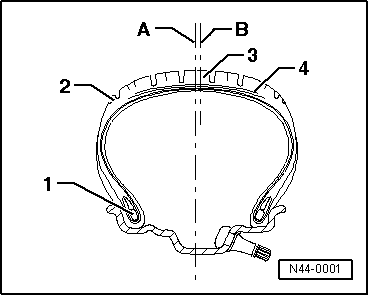| Representation with some exaggeration for a better visualization |
| 1 - | Misalignment of the tyre mesh/tyre
tread |
| F1 - | Unequal supporting forces of the wheel |
| F2 - | Unequal supporting forces of the wheel |
| Due to misalignment, a variable rigidity on the outer and
inner tyre shoulder is verified, and it leads to different supporting
forces of the wheel. Due to this, the mesh and the tyre tread do not
exert the same force (F1, F2) on the running lane. There is a cone.
The resulting force (conicity force Fk) may, depending on the speed,
become so strong that the vehicle pulls to one side. |
| If the force (Fk) in a axle wheel is 50 Newton, for example,
in the other wheel it is also 50 Newton, and if these forces act in
the same direction, they will have a cumulative effect. Turning the
tyre in relation to the wheel, it is possible to compensate the deviation
to the side, because the forces are opposite in their action. |
| Once it is not possible to visualize on the tyre the direction
that the conicity force acts, only with a driving test and a selective
wheel or tyre change it is possible to verify which tyre is causing
the deviation. |
| The tyre is composed by several components and materials that,
at the end of a very demanding manufacturing process, they are vulcanized
in a piece. Several manufacturing tolerances result from this process,
and they may be noticed through more or less strong side forces (side
conicity forces). These forces can happen on new tyres too. |
| The vehicle pulls to one side in the front axle. |
| The causes of this side deviation may be in the running gear.
Nevertheless, according to experience, in more than 90% of the claims,
the cause for vehicle's pulling to one side is the tyres. |
| The vehicle pulls to one side under normal driving. |
| Driving in a straight and flat surface, at constant velocity
or under moderate acceleration, the vehicle shows the trend of pulling
to one of the sides. A force at the steering wheel is felt. |
| The vehicle pulls to one side under strong acceleration. |
| In those vehicles equipped with front traction, if the vehicle
pulls to one of the sides under strong acceleration, it is concerned
in part with its own conception. The different friction ratios between
the left wheel and the right wheel or the occasional irregularities
on the pavement (deep potholes) and consequently the oscillating adherence
to the floor influence the driving features very much. It is not a
claim in the extent of warranty. |
|
|

|



